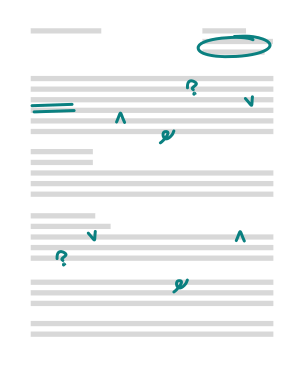Samples › CEO
CEO Sample
Download and customize our resume template to land more interviews. Review our writing tips to learn everything you need to know for putting together the perfect resume.


A CEO runs an entire organization and is one of the top executives. Below is a general job description:
A chief executive officer (CEO) is someone who is in charge of an organization and normally makes the vast majority of all business related executive decisions. In order to succeed at the position, a CEO must have great social skills, possess the ability to be an effective leader and not shy away from making big decisions. The specific job duties that are required from a CEO will vary depending on what type of organization they happen to be the leader of, as there could be a wide range of job responsibilities that may differ from one another.
Expert Tip
You should never use a creative resume
Many job seekers think that an eye-catching resume template will help them stand out to hiring managers and increase their chances of landing an interview. This is a myth put out by resume builders that value design over content.
The truth is that most hiring managers prefer a traditional resume format.
Creative resume templates, like the one pictured here, can actually hurt your chances of landing an interview. Instead, you should use a basic resume format that quickly communicates your basic information and qualifications–like the one included below.
CEO resume (text format)
How confident are you feeling about your resume? If you need more help, you can always refer to the following resume sample for a position.
Name
Title
City, State or Country if international
Phone | Email
LinkedIn URL
CEO PROFESSIONAL
A savvy, innovative, bilingual/multilingual C-Level Executive with experience leading organizations by providing expert business transformation services and cutting-edge technology solutions for multiple corporations. Ability to streamline organizational production through the restructuring of policies and procedures, operations, finances, customer service ratings and team productivity. Maintain an uncompromising focus on high quality standards and bottom-line profit improvements. Excel at turning under-producing businesses into companies that work efficiently and compete in the broader market.
CORE COMPETENCIES
Operations Management
Technology Advancements
Revenue Generation
Human Resources
Fiscal Accountability
P&L Management
Venture Capital
Training/Development
Business Expansion
PROFESSIONAL EXPERIENCE
CEO
ZipJob, New York NY | Year to Year
Responsibilities
Led company from years of operating losses to positive earnings, delivering significant improvements in one year by culminating XX% growth in operating earnings.
Revamped management personnel acquiring a new team award-wining managers, with proven records of delivering sustained growth, while challenging staff to exceed corporate expectations.
Led and motivated key management teams to peak levels of performance, consistently developing their coaching and leadership skills to increase overall productivity level.
Managed a technology and operations budget of $XXM and coordinate the efforts of XX staff members within XX management teams.
Consulted with the executive committees and senior management teams to review, evaluate and plan corporate-wide strategies and organizational initiatives to continually grow the business.
Led a comprehensive real estate strategy by researching new markets, identifying demographics and return on investment (ROI) and purchasing property to successful penetrate new business markets.
Ensured rapid, efficient and economical delivery of products to clientele by acquiring new technologies.
Spearheaded the development of a robust IT infrastructure, and acquired all hardware and software needed to create a paperless environment, saving the company $XX.
Chief Executive Officer
ZipJob, New York NY | Year to Year
Responsibilities
Created and directed the employee training programs and the company employee manual to create a centralized and productive work environment, where all employees are involved an able to thrive.
Championed innovative marketing strategy and execution, managing a $XX annual budget across trade and consumer advertising, market research, promotions, sales, marketing collateral, and business development.
Directed brand repositioning through an integrated three years product, corporate and consumer communications plan that increased brand awareness, attracted new business and doubled market share.
Recruited the company’s entire executive and management team and oversaw the hiring and development of XX associates, creating an empowering and collaborative work environment.
EDUCATION
Complete School Name, City, St/Country: List Graduation Years If Within the Last Ten Years
Complete Degree Name (Candidate) – Major (GPA: List if over 3.3)
Relevant Coursework: List coursework taken (even include those you are planning on taking)
Awards/Honors: List any awards, honors or big achievements
Clubs/Activities: List clubs and activities in which you participated
Relevant Projects: List 2-3 projects you have worked on
Everything you need to write your ceo resume
Now that you’ve seen an example of a job winning CEO resume, here are some tips to help you write your own. You should always begin with a summary section. Remember to use basic formatting with clear section headings and a traditional layout. Finally, be sure to include top skills throughout your resume. We’ve included several examples common for CEO below.
Let’s start with your resume summary section.
1. Summary
The resume summary replaces the out-of-date resume objective. A summary outlines the most impressive parts of your resume for easy recall by your potential employer, while also serving to fill in personal qualities that may not appear elsewhere on the page. Remember that summaries are short and consist of pithy sentence fragments! You can check out the CEO resume example for more information!
Expert Tip
Always start with your most recent positions at the top of your resume. This is called reverse-chronological format, and keeps your most relevant information easy for hiring managers to review.
2. Formatting
Our experts recommend you start your resume with a resume summary, like the one above. Other common sections are Work Experience, Education, and either Skills or Core Competencies. Here are some guides from our blog to help you write these sections:
Some resumes will include other sections, such as Volunteer Experience or Technical Skills. When it comes to what sections you need to include on your resume, you will know best!
Other sections for you to consider including are foreign language skills, awards and honors, certifications, and speaking engagements. These could all be relevant sections for your resume.

Join more than 1 million people who have already received our complimentary resume review.
In 48 hours, you will know how your resume compares. We’ll show you what’s working--and what you should fix.
3. Appropriate skills
Your resume should include all your skills that are relevant to your target job. Skills include both hard skills and soft skills. Hard skills are the technical know-how you need to complete a job, such as data analysis or HTML. You can include hard skills in your core competencies section. Soft skills are harder to quantify, so they require more information to explain your aptitude. Some top soft skill examples include communication, problem solving, and emotional intelligence. Use several examples of how you use your key soft skills throughout your work history, profile summary, and resume title.
4. Experience section
Your Work Experience section should make up the bulk of your resume. This section should include your relevant job titles, companies that employed you, and the dates you were employed.
Your Work Experience section should make up the bulk of your resume. This section should include your relevant job titles, companies that employed you, and the dates you were employed. Most people will finish this section by listing daily duties in short bullet points. Don't be one of them! To make your resume stand out, you need to add your accomplishments and key skills to your resume's Work Experience section. Here are three tips from our experts:
Use the STAR method to describe a situation, task, action, and result. This is adapted from a behavioral interview technique, so interviewers will recognize the format. it's also a great chance for you to organize your key accomplishments.
Don't forget about LinkedIn! The majority of employers are going to look you up on LinkedIn, so it's smart to make sure your LInkedIn profile is up to date and include your URL in your resume's contact section.
Always include a cover letter. Not everyone will bother, so it helps you look like a serious job applicant. It's also your chance to introduce yourself: who you are, why you're applying for this job, and how you want to proceed.
Let’s wrap it up!
Standout resumes will include a resume summary, a traditional reverse-chronological layout, and the skills and experience relevant to your job target. This resume example shows how to include those elements on a page. It’s up to you to insert your personal compelling qualifications.
Keep your resume format easy to scan by both humans and computers; our resume template is designed by our experts to satisfy both audiences. And be sure to include your own skills, achievements, and experiences. Job-winning resumes are resumes that successfully market you, leading recruiters and hiring managers to want to learn more!
Finally, emphasize your interest with a customized cover letter. When writing, remember that the resume and cover letter should support each other. Check out our cover letter tips and examples for more advice.
Didn’t get the specific answers you were looking for on this page? Hire a professional resume writer to get the advice you need to land your next job.
Related posts:

